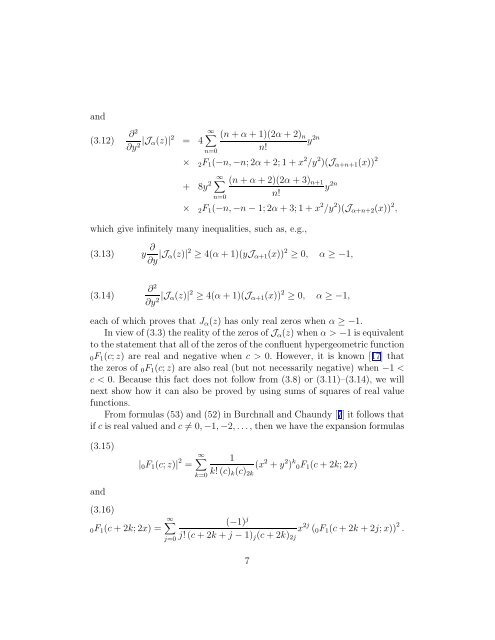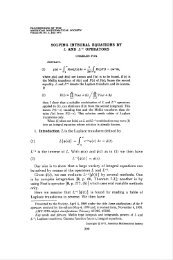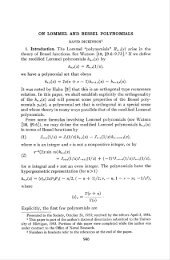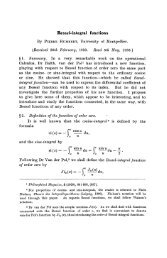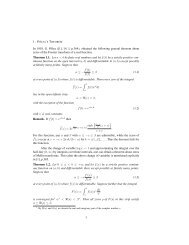G. Gasper Using sums of squares to prove that ... - Fuchs-braun.com
G. Gasper Using sums of squares to prove that ... - Fuchs-braun.com
G. Gasper Using sums of squares to prove that ... - Fuchs-braun.com
Create successful ePaper yourself
Turn your PDF publications into a flip-book with our unique Google optimized e-Paper software.
and<br />
(3.12)<br />
∂ 2<br />
∂y 2 |J α(z)| 2 = 4<br />
∞∑<br />
n=0<br />
(n + α + 1)(2α + 2) n<br />
y 2n<br />
n!<br />
× 2 F 1 (−n, −n; 2α + 2; 1 + x 2 /y 2 )(J α+n+1 (x)) 2<br />
+ 8y 2 ∞ ∑<br />
n=0<br />
(n + α + 2)(2α + 3) n+1<br />
y 2n<br />
n!<br />
× 2 F 1 (−n, −n − 1; 2α + 3; 1 + x 2 /y 2 )(J α+n+2 (x)) 2 ,<br />
which give infinitely many inequalities, such as, e.g.,<br />
(3.13)<br />
y ∂ ∂y |J α(z)| 2 ≥ 4(α + 1)(yJ α+1 (x)) 2 ≥ 0, α ≥ −1,<br />
(3.14)<br />
∂ 2<br />
∂y 2 |J α(z)| 2 ≥ 4(α + 1)(J α+1 (x)) 2 ≥ 0, α ≥ −1,<br />
each <strong>of</strong> which <strong>prove</strong>s <strong>that</strong> J α (z) has only real zeros when α ≥ −1.<br />
In view <strong>of</strong> (3.3) the reality <strong>of</strong> the zeros <strong>of</strong> J α (z) when α > −1 is equivalent<br />
<strong>to</strong> the statement <strong>that</strong> all <strong>of</strong> the zeros <strong>of</strong> the confluent hypergeometric function<br />
0F 1 (c; z) are real and negative when c > 0. However, it is known [17] <strong>that</strong><br />
the zeros <strong>of</strong> 0 F 1 (c; z) are also real (but not necessarily negative) when −1 <<br />
c < 0. Because this fact does not follow from (3.8) or (3.11)–(3.14), we will<br />
next show how it can also be <strong>prove</strong>d by using <strong>sums</strong> <strong>of</strong> <strong>squares</strong> <strong>of</strong> real value<br />
functions.<br />
From formulas (53) and (52) in Burchnall and Chaundy [7] it follows <strong>that</strong><br />
if c is real valued and c ≠ 0, −1, −2, . . ., then we have the expansion formulas<br />
(3.15)<br />
| 0 F 1 (c; z)| 2 =<br />
∞∑<br />
k=0<br />
1<br />
k! (c) k (c) 2k<br />
(x 2 + y 2 ) k 0F 1 (c + 2k; 2x)<br />
and<br />
(3.16)<br />
0F 1 (c + 2k; 2x) =<br />
∞∑<br />
j=0<br />
(−1) j<br />
j! (c + 2k + j − 1) j (c + 2k) 2j<br />
x 2j ( 0 F 1 (c + 2k + 2j; x)) 2 .<br />
7


